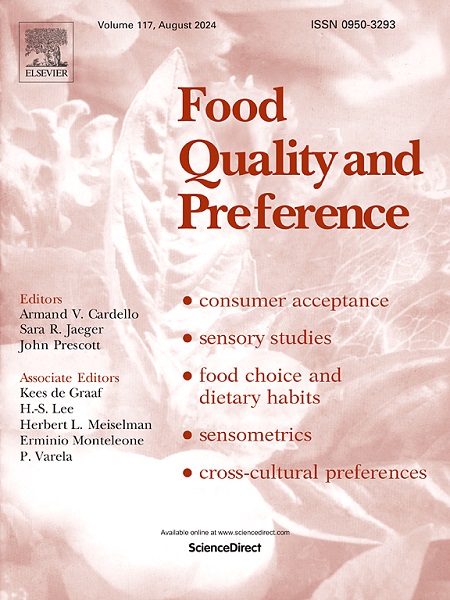儿童和人工智能能否为基于全食物利用的学校膳食制作提供创意?
IF 4.9
1区 农林科学
Q1 FOOD SCIENCE & TECHNOLOGY
引用次数: 0
摘要
让儿童参与学校膳食的制作,对于让他们养成健康和可持续的饮食习惯非常重要,而全食利用则是避免食物浪费和增加营养消耗的一种方法。此外,人工智能(AI)已被证明是一种有趣的新创意来源,但尚未被用于设计儿童膳食。这项工作的目的是评估由儿童共同设计或由人工智能生成的学校膳食的潜力,并探索家长对在儿童膳食中使用全食物的看法。在家长的潜在支持下,孩子们提出了含有全水果/蔬菜的食谱,营养学家和学校厨师对这些建议进行了筛选。所选菜肴与 ChatGPT 通过简单提示生成的类似菜谱进行了比较,以了解他们的接受程度和唤起的情感。这两道菜都是胡萝卜派食谱的变体,包括蔬菜皮,均由经验丰富的学校厨师制作。学校厨师提出的第三种食谱作为对比。通过句子完成法,了解了家长对孩子使用全食物的看法。结果显示,孩子们既喜欢自己的食谱,也喜欢厨师的食谱,但拒绝 ChatGPT 的食谱。厨师和孩子们的胡萝卜派都会引起积极的表情符号对,而 ChatGPT 的胡萝卜派则会引起消极的表情符号对。质地和不熟悉的味道被认为是拒绝的理由。对于家长来说,在儿童膳食中使用全水果/蔬菜是一个有营养的好主意,但也暴露出了安全问题。这项研究表明,与学童共同设计和利用全食物是减少营养资源浪费的可行策略。此外,该研究还报告了通过任务提示使用 ChatGPT 的不成功探索。这可能表明,在向人工智能发出提示时,必须明确任务的背景,以弥补人类隐含的背景信息。应解决安全方面的问题,以确保家长支持在学校膳食中使用全蔬菜。本文章由计算机程序翻译,如有差异,请以英文原文为准。
Can children and artificial intelligence be sources of ideas for school meal preparations based on whole food utilization?
Involving children in creation of school meals is important to engage them on healthy and sustainable eating habits, and the whole food utilization is a way to avoid food waste and increase the consumption of nutrients. Also, artificial intelligence (AI) has shown to be an interesting source of new ideas but has not been used for designing children’s meals. The aims of the work were to evaluate the potential of school meals either co-designed by children or generated with AI, and to explore parents’ perception towards the utilization of whole food in their children’s meal. Children, with the potential support of their parents, proposed recipes with whole fruit/vegetable utilization, and a selection among the suggestions was conducted by nutritionists and the school cooks. The selected meal was compared to a similar recipe from ChatGPT generated from a simple prompt with regard to their acceptance and emotions evoked. The two dishes were variations of carrot pie recipes including vegetable peel and were both prepared by experienced school cooks. A third recipe proposed by the school’s cooks was used as comparison. Parents’ perceptions towards whole food utilization to their children were elicited by sentence completion methodology. Results showed that children liked both their and the cooks’ recipes but rejected ChatGPT’s recipe. Both cooks’ and children’s carrot pies evoked positive emoji pairs, meanwhile ChatGPT’s carrot pie was associated to emojis of negative connotation. Texture and unfamiliar taste were cited to justify the rejection. For parents, the utilization of whole fruits/vegetable in children’s meals is perceived as a good and nutritious idea, but safety concerns were revealed. This work demonstrates co-design with school children and whole food utilization as actionable strategies towards reducing waste of nutritious resources. Moreover, the study reports an unsuccessful exploratory usage of ChatGPT through a task-focused prompt. This may suggest the importance of specifying the context of the task when prompting an AI, to compensate for contextual information that is implicitly available to humans. Concerns about safety aspects should be addressed to ensure parents’ support for whole vegetable utilization in school meals.
求助全文
通过发布文献求助,成功后即可免费获取论文全文。
去求助
来源期刊

Food Quality and Preference
工程技术-食品科技
CiteScore
10.40
自引率
15.10%
发文量
263
审稿时长
38 days
期刊介绍:
Food Quality and Preference is a journal devoted to sensory, consumer and behavioural research in food and non-food products. It publishes original research, critical reviews, and short communications in sensory and consumer science, and sensometrics. In addition, the journal publishes special invited issues on important timely topics and from relevant conferences. These are aimed at bridging the gap between research and application, bringing together authors and readers in consumer and market research, sensory science, sensometrics and sensory evaluation, nutrition and food choice, as well as food research, product development and sensory quality assurance. Submissions to Food Quality and Preference are limited to papers that include some form of human measurement; papers that are limited to physical/chemical measures or the routine application of sensory, consumer or econometric analysis will not be considered unless they specifically make a novel scientific contribution in line with the journal''s coverage as outlined below.
 求助内容:
求助内容: 应助结果提醒方式:
应助结果提醒方式:


